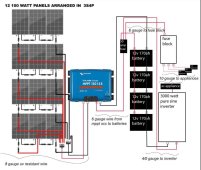TheCoachStone
New Member
Ok, I am looking at 10 310w panels. I can wire them in series for 100v and 40.25a. The panels have a series fuse of 15 and a short circuit current of 9.93.
If I am understanding correctly because my Isc is below my series fuse amperage I do not need to fuse? Or, am I missing something?
Controller is a LV6048 -
PV INPUT / Solar Charging
If I am understanding correctly because my Isc is below my series fuse amperage I do not need to fuse? Or, am I missing something?
Controller is a LV6048 -
PV INPUT / Solar Charging
- Max PV Input Power: 8000W (4000W each input)
- Max PV Input Volt: 145VDC (open circuit Voc)
- MPPT Range: 60 - 110VDC
- Number of PV Input: 2
- Max Charging Current: 160A (80A x 2)



